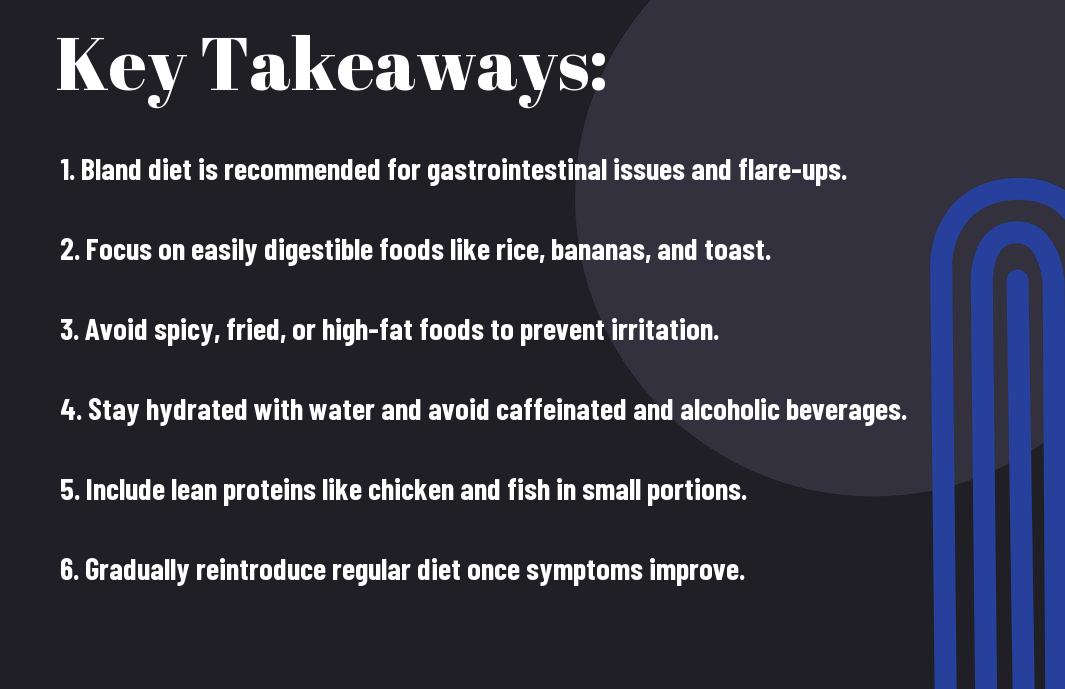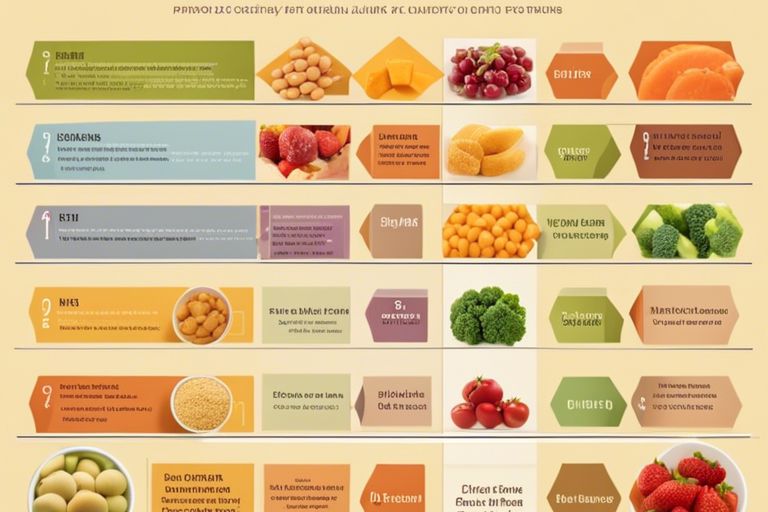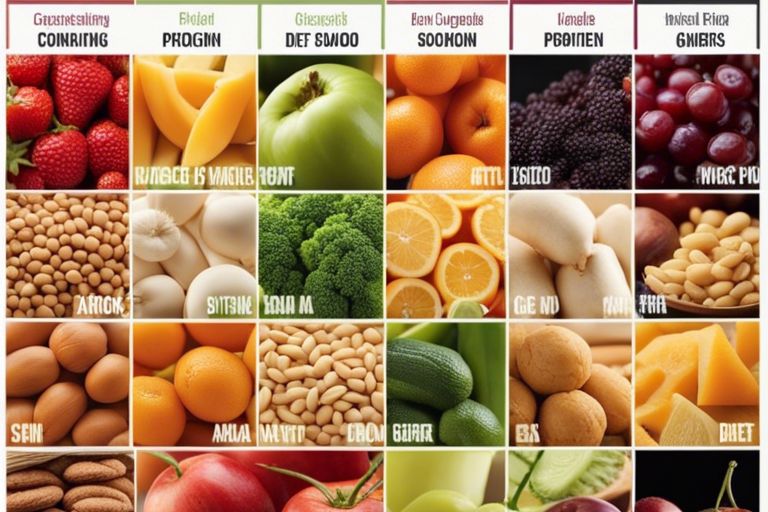Diet modifications can be challenging, especially when dealing with digestive issues, recovering from surgery, or managing certain medical conditions. The bland diet is a common recommendation in such cases, focusing on easy-to-digest foods that are gentle on the stomach. This complete chart will guide you through the ins and outs of the bland diet, helping you make informed decisions about what to eat and what to avoid to alleviate symptoms, promote healing, and maintain adequate nutrition.

Table of Contents
Understanding the Bland Diet
Definition and Key Principles
To successfully navigate the Bland Diet, it is important to understand its core principles. The Bland Diet is primarily composed of soft, low-fiber foods that are gentle on the digestive system. It aims to reduce irritation and inflammation in the digestive tract, making it ideal for individuals with gastrointestinal issues such as ulcers, gastritis, or irritable bowel syndrome.
Benefits and Limitations
The Bland Diet offers relief from digestive discomfort by eliminating spicy, acidic, and high-fat foods that can aggravate the stomach lining. However, its restrictive nature can lead to potential nutrient deficiencies if not carefully planned. It may lack crucial vitamins and minerals found in a varied diet, impacting overall health if followed for an extended period.
Another crucial point to consider is that while the Bland Diet can provide temporary relief for digestive ailments, solely relying on it for an extended period can result in nutrient deficiencies. It is crucial to consult a healthcare professional or a dietitian when considering long-term adherence to the Bland Diet to ensure adequate nutrient intake.

Foods to Include and Avoid
Safe Foods on the Bland Diet
Even with dietary restrictions, there are still plenty of safe and delicious options to enjoy on the bland diet. Stick to plain carbohydrates like white rice, oatmeal, and plain pasta. Opt for lean proteins such as skinless poultry, fish, and tofu. Include cooked or canned fruits without added sugar and soft, cooked vegetables like carrots and green beans.
Foods to Eliminate or Reduce
With the bland diet, it’s crucial to avoid spicy foods such as hot sauces, peppers, and chili powder. Cut out acidic foods like citrus fruits, tomatoes, and vinegar. Limit intake of high-fat foods like fried items, full-fat dairy, and fatty cuts of meat. Caffeine and alcohol should also be reduced or eliminated to prevent irritation to the digestive system.
Foods high in spices and seasonings can cause discomfort and worsen digestive issues for those following a bland diet. Acidic foods may trigger acid reflux and heartburn, leading to discomfort and pain. High-fat foods can be harder to digest and may exacerbate symptoms such as bloating and indigestion. By eliminating or reducing these items, individuals can better manage their symptoms and promote overall digestive health.
Creating Your Bland Diet Plan
Despite the restrictions that come with a bland diet, creating a plan can help you manage your symptoms and improve your digestive health.
Meal Planning and Preparation Tips
With meal planning playing a crucial role in sticking to a bland diet, it’s vital to be well-prepared. When preparing your meals, opt for boiled, steamed, or baked dishes as they are easier on the stomach. Incorporate lean proteins, such as chicken or fish, and avoid spicy seasonings to prevent irritation. Make sure to portion out your meals in advance to avoid any temptations to stray from your bland diet. Assume that having plain snacks like crackers or bananas will come in handy between meals.
Sample Meal and Snack Ideas
Tips for creating a bland diet include incorporating foods that are gentle on the stomach. For breakfast, consider oatmeal with a drizzle of honey or a smoothie made with plain yogurt and bananas. For lunch and dinner, opt for chicken vegetable soup or grilled fish with steamed carrots. For snacks, plain rice cakes or a chicken salad made with plain yogurt can satisfy your cravings. Diet modifications should be considered to help ease digestive discomfort and improve overall well-being.
Navigating Challenges
Dealing with Dietary Restrictions
Many individuals following a bland diet may encounter additional dietary restrictions due to allergies, intolerances, or underlying health conditions. It is crucial to carefully plan meals, ensuring they are both bland and adhere to these restrictions to prevent any adverse reactions. Consult a healthcare professional or dietitian to help create a suitable meal plan that meets all your dietary needs.
When to Update Your Diet Plan
RestrictionsWhen following a bland diet, it is imperative to regularly reassess your meal plan and make necessary adjustments. To maintain optimal health, consider updating your diet plan if you experience changes in your health status, such as weight loss or gain, digestive issues, or any new medical conditions. Consult with a healthcare provider to determine the best course of action.
Plus, incorporating a variety of nutrient-dense foods in your bland diet can help prevent nutrient deficiencies and improve overall health. Be sure to include a good balance of fruits, vegetables, whole grains, and lean proteins to ensure you are meeting your body’s nutritional needs.
Summing up
Presently, you hold the complete chart to navigate the bland diet successfully. By following the guidelines outlined here, you can manage your symptoms and improve your overall well-being. Remember to consult with a healthcare professional before making any drastic changes to your diet. With patience and dedication, you can find relief and maintain a balanced diet that suits your needs.
FAQ
Q: What is a bland diet?
A: A bland diet is a nutrition plan that focuses on foods that are easy to digest and gentle on the stomach. It typically includes foods that are low in fiber, soft in texture, and not too spicy or high in fat. This diet is often recommended for individuals experiencing digestive issues or recovering from certain medical conditions.
Q: What can I eat on a bland diet?
A: Foods allowed on a bland diet include cooked or canned fruits without skin or seeds, well-cooked vegetables without skin or seeds, lean protein sources such as skinless poultry or fish, refined grains like white bread and rice, and dairy products that are low in fat. It’s important to avoid spicy, fried, and high-fiber foods when following a bland diet.
Q: How long should I follow a bland diet?
A: The length of time you should follow a bland diet depends on the reason for implementing it. Some people may need to follow a bland diet for a short period, such as a few days to a week, to help alleviate digestive issues or during illness recovery. Others with chronic conditions may need to incorporate bland diet principles into their long-term eating habits. It’s best to consult with a healthcare provider or a dietitian to determine the appropriate duration for following a bland diet.
 hqsportz Personal Website | Tell Information about Sport, Fashion And Health
hqsportz Personal Website | Tell Information about Sport, Fashion And Health



